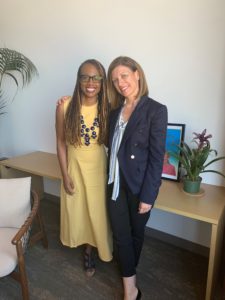
Kathleen Kelly Janus is the Senior Advisor on Social Innovation to Governor Gavin Newsom. As part of our Betting on the Bay interview series with Bay Area leaders, she recently sat down with Walter & Elise Haas Fund Executive Director Jamie Allison for a conversation about how we can promote leadership, philanthropy, and vibrancy here in the Bay Area. An edited transcript of that discussion follows.
Jamie Allison: Thanks for joining me, Kathleen. Can we start by talking about your role in the Governor’s office? The role of Senior Advisor on Social Innovation is new; what’s your mandate? What are your priorities?
Kathleen Kelly Janus: As the Senior Advisor on Social Innovation, I’m in charge of public-private partnerships to support the Governor’s agenda. That means I spend half my time in the Governor’s office in Sacramento, meeting with the policy team, meeting with the senior advisors, and maintaining a handle on where the opportunities for public-private partnerships lie. Then I spend the remaining half of my time around the state meeting with community leaders, nonprofits, foundations, philanthropists, and businesses identifying opportunities to leverage each sectors’ strength.
I view myself as a matchmaker, helping to bring everybody to the table to address the challenges we’re facing.
JA: What are some of the partnerships you’re working on?
KKJ: One example is the collaboration happening around the 2020 census. Ten years ago, philanthropic leaders realized that if we were going to be effective in counting California residents we were going to need to invest in community based organizations and advocacy to ensure structures were in place for the census. Philanthropy committed $30 million to achieving an accurate census count over those ten years.
Philanthropy really took a leadership role in this. Its contributions will be absolutely critical in reaching hard-to-count populations in nimble ways. Nimble is not how you typically describe government, but philanthropy definitely can be. They’re organizing things including hyper-local message testing, investing in below-the-radar community organizations, and those organizations that lack the ability to apply for state funding.
In another example, philanthropy is coming together with the Future of Work commission to support an organization called the Institute for the Future, which is going to be providing the research, the innovation, the access, and the on-the-ground insight for a policy agenda that increases opportunities for workers.
But we can’t solve the really tough issues in our state without engaging business. In the nonprofit, philanthropic sector, we have the tendency to frame business as part of the problem. And Governor Newsom is committed to ensuring that, instead, business is part of the solution.
We’re in the process of developing a master plan around early childhood, for example, so we have a plan that gets us to universal preschool education. There is an opportunity for business to support this effort by providing early childhood care for their employees or stipends for preschool education.
If any businesses are out there and ready to make that deal, consider this your official invitation to the table!
JA: Can you talk about what skills or attributes you think future civic leaders need?
KKJ: Over the past five years, I have been researching how nonprofits succeed and grow. I sat down with leaders, their boards, their beneficiaries and funders, and I came up with five strategies that I talked about in my book, Social Startup Success.
In all those conversations, I kept waiting for someone to say, “It’s grit or charisma that gets someone ahead,” but no one said that. They all kept pointing back to these five strategies: innovation, measuring impact, leadership, fundraising, and storytelling. These strategies are teachable but we’re not teaching them to young people graduating from high school or college that we need to act as strong advocates in our communities
 JA: Has philanthropy played a role in your leadership journey?
JA: Has philanthropy played a role in your leadership journey?
KKJ: Being a young lawyer in San Francisco who was starting a small nonprofit — Spark — I ran into this false dichotomy; that either I was supposed to go into corporate work and make money or go into nonprofit work and do good. But this misunderstanding hinders us from improving our communities, whichever direction we choose.
We all have the capacity to make a difference, whether by volunteering, donating, serving on a board, or attending events. These are all opportunities to make our world better.
We do a disservice to young people by inhibiting them from taking leadership roles as activists in their communities.
JA: What should we be doing to prepare young people to take on leadership roles?
KKJ: We need to change the education system. My approach to teaching has always been a community engaged learning approach. I learned that way in law school and it was transformative. It allowed me to practice in a law firm and spend 30% of my time on civil rights immigration cases.
We also need to give young people opportunities to volunteer and serve on boards. Too often organizations are focused on high-net-worth donors when it comes to board seats. That leaves out the chance to bring in young people and build the pipeline. Young people most often don’t have a lot of money, but they have skills, networks, and connections.
The more that we can give young people opportunities to give back the better we’ll cultivate the spirit of generosity and service that can last throughout the course of an entire life.
JA: Is there an interesting fact or a statistic or story about California that surprised you, in the context of your new role.
KKJ: How about this: we have $200 per capita philanthropic giving in the Bay Area versus $7 per capita giving in the Central Valley. That data point highlights the lack of opportunity that nonprofit leaders have in different parts of our state.
All the things we talk about in the context of leadership development — hiring an executive coach, taking courses — shouldn’t be a luxury, but most often they are. As a nonprofit leader, it should be feasible to learn and grow instead of just struggling to make payroll every month.
That lack of opportunity really holds our communities back.
I heard a statistic the other day that 75% of venture capital is invested in four states in the nation. I don’t know the statistics in California, but my guess is that the vast majority of venture capital goes to the Bay Area and Los Angeles, leaving the rest of the state behind. We need to ensure that all Californians have access to the California dream and we need to think about demographic equity.
JA: I was just talking to a pair of fourth grade students who expressed concern about climate change. How would you address their concerns?
KKJ: Governor Newsom is making climate change a factor as he plans his agenda — so that it’s in there right from the beginning.
For example, he’s thinking about where people are working and where the jobs are located. We have folks commuting six hours a day by car and that’s a climate hazard. If we can create jobs in their communities, that not only improves their quality of life, it also reduces emissions.
The governor also just led an initiative around clean cars. He solicited 24 other governors to sign a letter asking President Trump not to roll back the emissions standards, and successfully convinced the car companies to maintain the better standard. Given that nearly half of our state’s emissions come from vehicles alone, this has the capacity to make a huge dent in our climate change goals. There’s a lot of opportunity for California to take a leadership role in climate and that’s what we’ve always done.
JA: Here’s something I’ve been asking everyone as part of this series: what does it mean for city or region to be vibrant?
KKJ: Vibrancy comes from thriving innovation, finding new ways of addressing old problems. Social innovation, business innovation, and artistic innovation.
We need to invest all of these different sectors in order to have a vibrant community.
JA: How about some fun questions? If you unexpectedly had a day off, where might we find you?
KKJ: With my kids. That’s the hard part about being a working mom; you don’t get to spend as much time with your kids as you like. I’d be hanging with them at the park, or at the beach, or if they are lucky having a Bi-Rite ice cream.
JA: Who inspires you in the Bay Area?
KKJ: My husband. He is my biggest cheerleader and he starts every day by telling me what a rock star I am and how I’m going to go out there and kill it and change the world and make a difference. And I feel like I’m so lucky to have this voice in the back of my head always reminding me that I’m doing my best.
JA: That is fantastic. And what music are you listening to right now?
KKJ: I usually sing at the top of my lungs to pop stars. My kids like Taylor Swift. So, I get roped into Taylor Swift, but I’m pretty happy with any pop music.
JA: Thank you so much.
KKJ: My pleasure!
In addition to her work in Governor Newsom’s office, Kathleen Kelly Janus is a social entrepreneur and Stanford University lecturer. She shares her expertise on philanthropy, millennial engagement, and scaling startup organizations through her classes, and she is the author of Social Startup Success: How the Best Nonprofits Launch, Scale Up and Make a Difference. Kathleen Kelly Janus has led social justice initiatives as an attorney, co-founded Spark – a network of millennial donors – and helped launch and direct Stanford Law School’s international human rights clinics in Namibia and South Africa.

